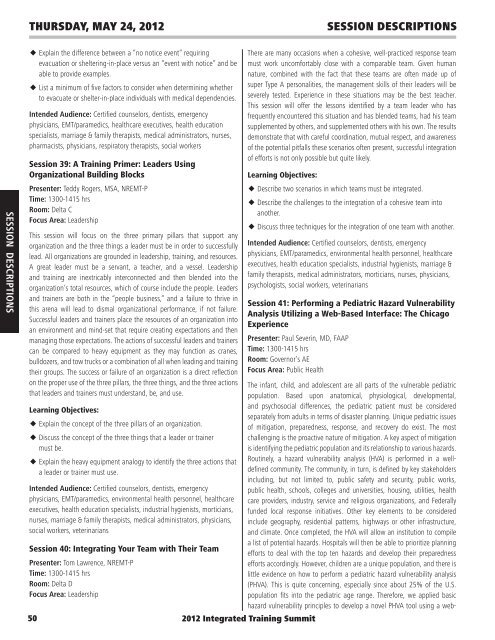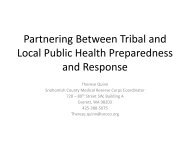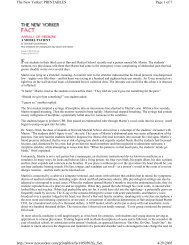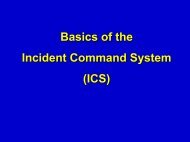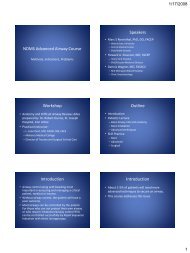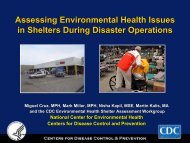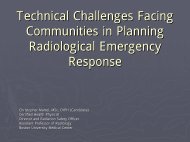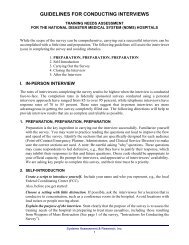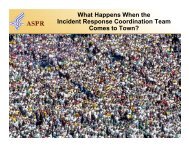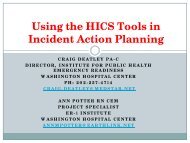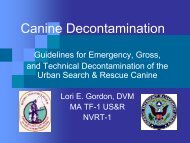THURsday, May 24, <strong>2012</strong>Session Descriptions<strong>The</strong> infant, child, and adolescent are all parts of the vulnerable pediatricpopulation. Based upon anatomical, physiological, developmental,and psychosocial differences, the pediatric patient must be consideredseparately <strong>from</strong> adults in terms of disaster planning. Unique pediatric issuesof mitigation, preparedness, response, and recovery do exist. <strong>The</strong> mostchallenging is the proactive nature of mitigation. A key aspect of mitigationis identifying the pediatric population and its relationship to various hazards.Routinely, a hazard vulnerability analysis (HVA) is performed in a welldefinedcommunity. <strong>The</strong> community, in turn, is defined by key stakeholdersincluding, but not limited to, public safety and security, public works,public health, schools, colleges and universities, housing, utilities, healthcare providers, industry, service and religious organizations, and Federallyfunded local response initiatives. Other key elements to be consideredinclude geography, residential patterns, highways or other infrastructure,and climate. Once completed, the HVA will allow an institution to compilea list of potential hazards. Hospitals will then be able to prioritize planningefforts to deal with the top ten hazards and develop their preparednessefforts accordingly. However, children are a unique population, and there islittle evidence on how to perform a pediatric hazard vulnerability analysis(PHVA). This is quite concerning, especially since about 25% of the U.S.population fits into the pediatric age range. <strong>The</strong>refore, we applied basichazard vulnerability principles to develop a novel PHVA tool using a websessionDescriptionsu Explain the difference between a “no notice event” requiringevacuation or sheltering-in-place versus an “event with notice” and beable to provide examples.u List a minimum of five factors to consider when determining whetherto evacuate or shelter-in-place individuals with medical dependencies.Intended Audience: Certified counselors, dentists, emergencyphysicians, EMT/paramedics, healthcare executives, health educationspecialists, marriage & family therapists, medical administrators, nurses,pharmacists, physicians, respiratory therapists, social workersSession 39: A Training Primer: Leaders UsingOrganizational Building BlocksPresenter: Teddy Rogers, MSA, NREMT-PTime: 1300-1415 hrsRoom: Delta CFocus Area: LeadershipThis session will focus on the three primary pillars that support anyorganization and the three things a leader must be in order to successfullylead. All organizations are grounded in leadership, training, and resources.A great leader must be a servant, a teacher, and a vessel. Leadershipand training are inextricably interconnected and then blended into theorganization’s total resources, which of course include the people. Leadersand trainers are both in the “people business,” and a failure to thrive inthis arena will lead to dismal organizational performance, if not failure.Successful leaders and trainers place the resources of an organization intoan environment and mind-set that require creating expectations and thenmanaging those expectations. <strong>The</strong> actions of successful leaders and trainerscan be compared to heavy equipment as they may function as cranes,bulldozers, and tow trucks or a combination of all when leading and trainingtheir groups. <strong>The</strong> success or failure of an organization is a direct reflectionon the proper use of the three pillars, the three things, and the three actionsthat leaders and trainers must understand, be, and use.Learning Objectives:u Explain the concept of the three pillars of an organization.u Discuss the concept of the three things that a leader or trainermust be.u Explain the heavy equipment analogy to identify the three actions thata leader or trainer must use.Intended Audience: Certified counselors, dentists, emergencyphysicians, EMT/paramedics, environmental health personnel, healthcareexecutives, health education specialists, industrial hygienists, morticians,nurses, marriage & family therapists, medical administrators, physicians,social workers, veterinariansSession 40: Integrating Your Team with <strong>The</strong>ir TeamPresenter: Tom Lawrence, NREMT-PTime: 1300-1415 hrsRoom: Delta DFocus Area: Leadership50<strong>The</strong>re are many occasions when a cohesive, well-practiced response teammust work uncomfortably close with a comparable team. Given humannature, combined with the fact that these teams are often made up ofsuper Type A personalities, the management skills of their leaders will beseverely tested. Experience in these situations may be the best teacher.This session will offer the lessons identified by a team leader who hasfrequently encountered this situation and has blended teams, had his teamsupplemented by others, and supplemented others with his own. <strong>The</strong> resultsdemonstrate that with careful coordination, mutual respect, and awarenessof the potential pitfalls these scenarios often present, successful integrationof efforts is not only possible but quite likely.Learning Objectives:u Describe two scenarios in which teams must be integrated.u Describe the challenges to the integration of a cohesive team intoanother.u Discuss three techniques for the integration of one team with another.Intended Audience: Certified counselors, dentists, emergencyphysicians, EMT/paramedics, environmental health personnel, healthcareexecutives, health education specialists, industrial hygienists, marriage &family therapists, medical administrators, morticians, nurses, physicians,psychologists, social workers, veterinariansSession 41: Performing a Pediatric Hazard VulnerabilityAnalysis Utilizing a Web-Based Interface: <strong>The</strong> ChicagoExperiencePresenter: Paul Severin, MD, FAAPTime: 1300-1415 hrsRoom: Governor’s AEFocus Area: Public Health<strong>2012</strong> Integrated Training Summit
THURsday, May 24, <strong>2012</strong>Session Descriptionsbased interface. <strong>The</strong> setting of our PHVA was the city of Chicago. <strong>The</strong>process details probability, risk, and preparedness for human, technological,and natural events that may occur within a hospital’s area of operationswith a focus on the pediatric population. <strong>Through</strong> a web-based interface,supplemental information and reference material assist subject matterexperts as they prepare their PHVA report. This process will step the usersthrough the PHVA, so at the conclusion they will have a digital, printabledocument containing the required PHVA tables. User-based profiles willallow specified users to initiate their individual reports, save their work, andreturn to update, review, and print their PHVA report as needed. Our majorgoal is to demonstrate the PHVA process and provide lessons learned.Learning Objectives:u Demonstrate the utility of geographic information systems whenperforming a pediatric hazard vulnerability analysis.u Implement a web-based approach to performing a hospital pediatrichazard vulnerability analysis.u Apply lessons learned when considering the performance of apediatric hazard vulnerability analysis.Intended Audience: Emergency physicians, EMT/paramedics, healthcareexecutives, health education specialists, medical administrators, nurses,physicians, respiratory therapistsSession 42: Partnering between Tribal and Local PublicHealth <strong>Preparedness</strong> and ResponsePresenters: Jason Debronz, MA; Sandy Evans, MPH, RN;<strong>The</strong>rese Quinn, BA; Lee ShipmanTime: 1300-1415 hrsRoom: Bayou ABFocus Area: Public HealthPresenters will provide information about collaborative efforts in WashingtonState and Okeechobee County, Florida. <strong>The</strong> emergency management director<strong>from</strong> the Shoalwater Bay Indian tribe and the emergency managementoperations manager for the Seminole tribe of Florida will join the MedicalReserve Corps (MRC) coordinators <strong>from</strong> the Tulalip tribes and SnohomishCounty. Three members of the panel <strong>from</strong> Washington State will discusshow they have worked together on public health preparedness andresponse with a focus on participation in the regional healthcare coalitions.Healthcare coalitions are regional partnerships that work to improve ourability to meet the dramatically increased demand for medical care that isexpected during a major health emergency. Healthcare coalitions consist ofrepresentatives <strong>from</strong> public health, hospitals, tribal health clinics, healthcareproviders, emergency medical services, home health care, long-term care,mental health, MRC, and emergency management. <strong>The</strong> panel member <strong>from</strong>the Seminole tribe of Florida will discuss how the tribe has worked withlocal, state, and Federal agencies for emergency preparedness and responsebefore, during, and after any disaster. He will also discuss the relationshipthat was built with the Okeechobee Medical Reserve Corps during the H1N1pandemic. <strong>The</strong> sessions will focus on the collaboration between tribes,counties, city, and state entities with an emphasis through the work of theMRC. Audience members will be encouraged to share their challenges andsuccesses in similar efforts in their local community. <strong>The</strong> presenters willfacilitate a conversation to explore ways that tribal, county, city, and stateorganizations can work together to benefit public health preparedness andresponse.Learning Objectives:u Describe the importance of partnering between tribal, local, and statejurisdictions for public health preparedness.u Identify stragegies to jointly build resilience that will be successful forparticipants in the local community.u Examine the benefits to both tribal and local jurisdictions ofpartnership in public health preparedness.Intended Audience: Certified counselors, dentists, emergencyphysicians, EMT/paramedics, healthcare executives, health educationspecialists, marriage & family therapists, medical administrators, nurses,physicians, psychologists, social workersSession 43: Where the Public Is @: Or How I Learned toStop Worrying and Love Social MediaPresenter: James Garrow, MPHTime: 1300-1415 hrsRoom: Governor’s CFocus Area: Resource Management and Patient MovementCrisis communication today is a vastly different animal than it was just fiveyears ago. <strong>The</strong> average time it takes for a story to be picked up and splayedacross the media has shrunk <strong>from</strong> days to minutes. <strong>The</strong> very definitionof who is a member of the media has changed. Many government andhealthcare communicators are struggling to keep up with the changesand feeling overwhelmed by the greatly expanded demands placed ontheir office due to these “new media.” This session will feature a tour ofthe most important social media websites and allow for discussion of therelative benefits—and shortcomings—of each. Examples will be woventhroughout the session to give guidance on how, and how not to, integratesocial media into an agency’s or organization’s crisis communication plans.Special attention will be paid to satisfying those in an organization who areuncomfortable with using social media, and techniques for addressing thoseconcerns will be developed and provided. Specific considerations that willbe addressed include: policy, goals, and procedures development; precrisisand crisis messaging; tailoring messages for different audiences, especiallyvulnerable and underserved populations; opportunities to continue learningabout social media.Learning Objectives:u Describe the relative benefits and shortcomings of four social medianetworks and how each can be used before, during, and after a crisis.u Describe how to integrate social media into communications plans,policies, and procedures, with a special focus on liability concerns.u Describe two best practice examples that demonstrate how socialmedia can effectively reach and engage traditionally vulnerable andunderserved populations.session Descriptions<strong>2012</strong> Integrated Training Summit 51
- Page 1 and 2: Leading from PreparednessThrough Re
- Page 3 and 4: Table of ContentsAmericans with Dis
- Page 5 and 6: Integrated Training Summit Partner
- Page 7 and 8: Focus area DescriptionsFocus Area D
- Page 9 and 10: Late Breakers & Early RisersTuesday
- Page 11 and 12: Handy Perforated Daily Agendas - De
- Page 13 and 14: Handy Perforated Daily Agendas - De
- Page 15 and 16: Handy Perforated Daily Agendas - De
- Page 17 and 18: Handy Perforated Daily Agendas - De
- Page 19 and 20: WorkshopDescriptions2012 Integrated
- Page 21 and 22: Monday, May 21, 2012Workshop Descri
- Page 23 and 24: MoNday, May 21, 2012Workshop Descri
- Page 25 and 26: MoNday, May 21, 2012Workshop Descri
- Page 27 and 28: Tuesday, May 22, 2012Workshop Descr
- Page 29 and 30: WEDNESday, May 23, 2012dMIS Worksho
- Page 31 and 32: ThurSday, May 23, 2012dMIS Workshop
- Page 33 and 34: SessionDescriptionssession Descript
- Page 35 and 36: wednesday, May 23, 2012Session Desc
- Page 37 and 38: wednesday, May 23, 2012Session Desc
- Page 39 and 40: wednesday, May 23, 2012u Provide ex
- Page 41 and 42: wednesday, May 23, 2012Session Desc
- Page 43 and 44: wednesday, May 23, 2012Session Desc
- Page 45 and 46: Thursday, May 24, 2012Session Descr
- Page 47 and 48: THURsday, May 24, 2012Session Descr
- Page 49: THURsday, May 24, 2012Session Descr
- Page 53 and 54: THURsday, May 24, 2012Session Descr
- Page 55 and 56: THURsday, May 24, 2012Session Descr
- Page 57 and 58: FRIday, May 25, 2012Session Descrip
- Page 59 and 60: Tuesday, May 22, 2012MRC WorkshopsM
- Page 61 and 62: Tuesday, May 22, 2012MRC WorkshopsL
- Page 63 and 64: Continuing Education InformationCon
- Page 65 and 66: Continuing Education InformationSes
- Page 67 and 68: Planning CommitteeDawn AnastasiaChe
- Page 69 and 70: PresentersBrian Abrahamson, BAGaylo
- Page 71 and 72: PresentersMary Massey, BSN, MA, MEP
- Page 73 and 74: Presenter DisclosuresAlliance betwe
- Page 75 and 76: 2012 Poster PresentationsMRCPoster
- Page 77 and 78: 2012 Poster PresentationsApplicatio
- Page 79 and 80: 2012 Poster PresentationsCollaborat
- Page 81 and 82: 2012 Poster PresentationsEducation
- Page 83 and 84: 2012 Poster PresentationsSpecial Co
- Page 85 and 86: Integrated Training Summit Acronym


